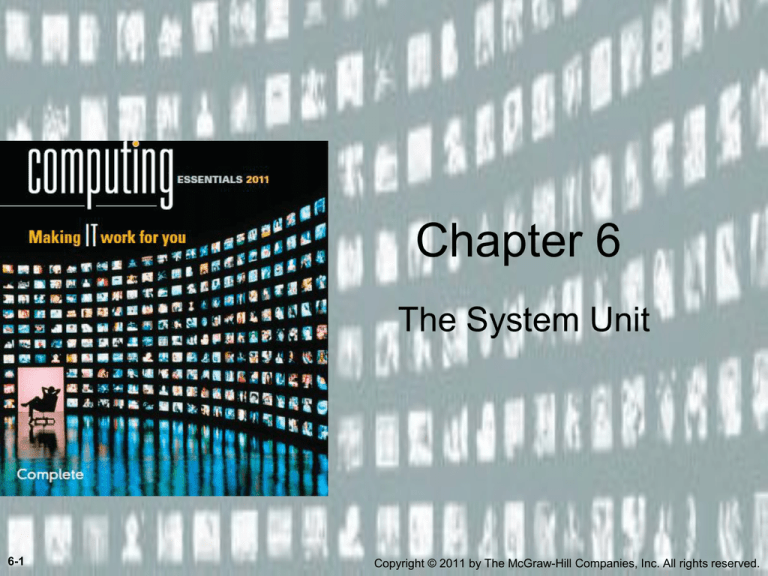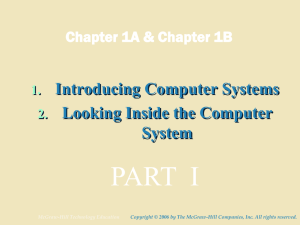
Chapter 6
The System Unit
6-1
Copyright © 2011 by The McGraw-Hill Companies, Inc. All rights reserved.
Competencies (1 of 2)
• Describe the six basic types of system units
• Discuss how a computer uses binary codes to
represent data in electronic form
• Describe each of the major system unit
components
• Discuss microprocessors, including specialty
processors
• Describe the different types of memory
6-2
Copyright © 2011 by The McGraw-Hill Companies, Inc. All rights reserved.
Competencies (2 of 2)
• Discuss expansion slots and boards
• Describe five principal types of expansion buses
• Discuss four standard ports and four specialized
ports
• Discuss power
supply for desktop
and notebook
computers
6-3
Copyright © 2011 by The McGraw-Hill Companies, Inc. All rights reserved.
System Unit
6-4
Copyright © 2011 by The McGraw-Hill Companies, Inc. All rights reserved.
System Unit Types
• Desktop System Units
• Media Center System Units
• Notebook System Units
• Tablet PC System Units
• Handheld Computer
System Units
6-5
Copyright © 2011 by The McGraw-Hill Companies, Inc. All rights reserved.
Electronic Data and Instructions
• Data and instructions are represented
electronically
• Two-state system or Binary System
–
–
–
–
6-6
Off/on electrical states
Characters represented by 0s (off) and 1s (on)
Bits
Bytes
Copyright © 2011 by The McGraw-Hill Companies, Inc. All rights reserved.
Character Coding Schemes
• Three types of binary
coding schemes
– ASCII - American
Standard Code for
Information Exchange
– EBCDIC - Extended
Binary Coded Decimal
Interchange Code
– Unicode – handles
languages with large
numbers of characters
6-7
Copyright © 2011 by The McGraw-Hill Companies, Inc. All rights reserved.
System Board
•
•
•
•
Connects all components
Allows communication between devices
Main board or motherboard
Circuit board
electronic components
– Sockets
– Slots
– Bus lines
6-8
Copyright © 2011 by The McGraw-Hill Companies, Inc. All rights reserved.
Microprocessor Chips
• Central Processing Unit (CPU)
• Two Basic Components
– Control unit
– Arithmetic-logic unit (ALU)
6-9
Copyright © 2011 by The McGraw-Hill Companies, Inc. All rights reserved.
Microprocessor Chips
• Chip capacities are expressed in word sizes
• Two Recent Significant Developments
– 64-bit processors
• Have become standard for most of
today’s desktop and laptop computers
– Multi-Core Chips
• Can provide two
separate and
independent CPUs
• Parallel processing
6-10
Copyright © 2011 by The McGraw-Hill Companies, Inc. All rights reserved.
Memory
• Holding area for data, instructions, and
information
• Memory is contained on chips connected to the
system board
• Types of memory chips
– RAM
– ROM
– Flash
6-11
Copyright © 2011 by The McGraw-Hill Companies, Inc. All rights reserved.
RAM
• Random Access Memory (RAM) chips hold the
program and data
– Cache memory or RAM cache
– Flash RAM or flash memory
• Other types of RAM
–
–
–
–
DRAM
SDRAM
DDR
Direct RDRAM
Return
6-12
Copyright © 2011 by The McGraw-Hill Companies, Inc. All rights reserved.
ROM
• Read-only memory (ROM) chips are not volatile
and cannot be changed by the user
• CPU can read, or retrieve data and programs
but the computer cannot write
• Contain special instructions
– Needed to start a computer
– Give keyboard keys their special capabilities
– Put characters on screen
Return
6-13
Copyright © 2011 by The McGraw-Hill Companies, Inc. All rights reserved.
Flash
• Flash memory offers a combination of the
features of RAM and ROM.
• Flash memory is used for a wide of range
of applications.
• If changes are made to the computer
system, these changes are reflected in
flash memory.
6-14
Copyright © 2011 by The McGraw-Hill Companies, Inc. All rights reserved.
Expansion Slots and Cards
• Allow for new devices to
be added
– Open architecture
– Slots provide for expansion
• Expansion cards are
also called …
–
–
–
–
6-15
Plug-in boards
Controller cards
Adapter cards
Interface cards
Copyright © 2011 by The McGraw-Hill Companies, Inc. All rights reserved.
Commonly Used Expansion
Cards
•
•
•
•
•
•
6-16
Graphics cards
Sound cards
Modem cards
Network interface cards (NIC)
PC cards and Express cards
TV tuner cards
Copyright © 2011 by The McGraw-Hill Companies, Inc. All rights reserved.
TV Tuner Cards And
Video Clips
• Allows you to view your favorite TV shows while
running other applications such as Excel
• Video can be captured to a file, added to a Web
page, attached to an email, or added to a class
presentation
• Relatively inexpensive
and easy to install
6-17
Copyright © 2011 by The McGraw-Hill Companies, Inc. All rights reserved.
Plug and Play
• Set of specific hardware and software standards
developed by Intel, Microsoft, and others
• Creating devices that are able to configure
themselves when installed
6-18
Copyright © 2011 by The McGraw-Hill Companies, Inc. All rights reserved.
Bus Lines
• Connect parts of the CPU to each other
• Data roadway for traveling bits
– Measured as bus width
– More lanes, faster traffic
• Two basic categories
– System buses
– Expansion buses
6-19
Copyright © 2011 by The McGraw-Hill Companies, Inc. All rights reserved.
Expansion Buses
• Connects the CPU to other components on the
system board, including expansion slots
• Principal types
–
–
–
–
–
6-20
PCI Express (PCIe)
Peripheral Component Interconnect (PCI)
Universal serial bus (USB)
FireWire buses
Serial Advanced Technology Attachment (SATA)
Copyright © 2011 by The McGraw-Hill Companies, Inc. All rights reserved.
Ports
• Socket for connecting external devices
• Ports can connect directly to the system board or
they can connect to cards that are inserted into
slots on the system board
• Three Types
– Standard Ports
– Legacy Ports
– Specialized Ports
6-21
Copyright © 2011 by The McGraw-Hill Companies, Inc. All rights reserved.






